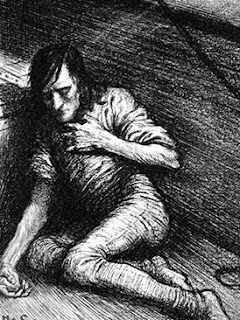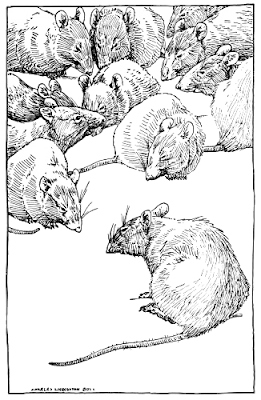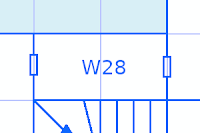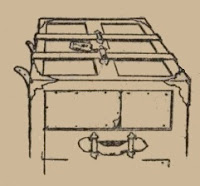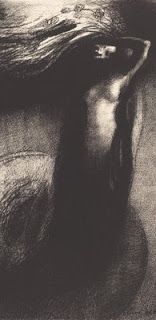AD&D is a wealth of information - the DMG, while cumbersome to reference, an amazing resource with an answer (not always the best answer, but a functional, thought-out answer) to almost anything that a referee might encounter and desire to rule in a standard campaign. Among these rules are rules for diseases and parasites - a subject, in B/X, which is fairly sparse: the only reference to disease being in the "Rats," "Lycanthropes," and "Mummy" monster profiles.
In the spirit of the relative simplicity of B/X over (under?) AD&D, I present the following alternate to adjudication of disease:
Adjudicating Disease
Disease exposure can occur in one of two ways - by direct attack from an infection source (plague-rat bite, mummy attack, fetid arrow, etc.) or randomly in a poor environment (swamps, sewers, dirty urban environments, etc.). For direct exposure, the condition to check for disease is self-explanatory: for environmental exposure, disease should be added to the random encounter table for wilderness or urban exploration for the environment affected.
Disease Profiles
Each disease has a disease profile, included in which are two essential points:
- Symptoms
- Severity Thresholds
The symptoms of a disease include in-game effects of the disease (penalties to statistics, impacts to mechanics, etc.) as well as flavor, depth to the taste of the game (fever, nausea, etc.). The severity thresholds of a disease is a number corresponding to the severity and recovery times of the disease. The lower these thresholds, the more virulent and more dangerous the disease is.
The duration of the disease - or, how long the infection persists active - is, unless otherwise specified, a number of hours, days, or weeks (as specified by the affecting symptom) equal to half the raw value on the ones die of the percentile roll.
A sample disease common in the middle ages might be profiled as follows:
| Devils' Laughter | ||
| Threshold | Symptoms | |
|---|---|---|
| 60 | A mild fever, periodic bouts of giggling. -2 Wisdom, -1 Constitution; Duration: days. | |
| 80 | Fever, constant laughter, periodic bouts of hilarity. -4 Wisdom, -2 Constitution; Duration: days. | |
| 120 | High fever, uncontrollable laughter, seizures. -8 Wisdom, -4 Constitution; Duration: weeks. If the Duration multiple is odd, coma and death follow. | |
Infection Procedure
Upon exposure to disease, 1d% is rolled and the result is modified as follows:
- The character's age is added to the roll.
For character races whose life span does not parallel a Human's, add the relative percentage that race is into its natural life span instead: so, a 60 year old Dwarf, which (per AD&D) lives about 4 times as long as a Human, would add ~15. - The character's Save vs Death threshold is added to the roll. Thus, if our Dwarf from before was of 6th level, they would add a further 6.
The resulting value then is compared to the disease's severity threshold to determine the effect of the disease on the character: based on the disease's defined symptoms, no further roll is needed.
It is at the referee's discretion as to whether the player or the referee makes this roll, though preference is given by the author to the player.
If the referee makes like rolls at your table - by all means, continue your paradigm: consistency being important - however, this being in place of a save where a player will be accustomed to rolling saves, it would lend both muscle-consistency to the mechanism and put accountability for the consequences on the player.
Exceptional Constitution (Optional)
Optionally, a referee may subtract from the roll 5 times the Hit Point modifier granted to the character by their Constitution - such that a character of +2 HP per level would reduce the result by 10, where a character of -1 HP per level would increase the result by 5.
Note that, because this is a nested expression - that is, it is not a straight up, "add this to the roll," but instead, "calculate this and then add it to the roll" - it will be slightly slower at the table. It may be calculated in advance and recorded - as a character's Constitution doesn't change very often - however be aware of the impact it will have.
Medical Treatment (Optional)
Characters may undergo medical treatment to reduce the impact or speed recovery from diseases. If a character - upon having come down with a disease - receives 1d10 to roll.
- If the medical aid is being administered by a professional - a physician, an apothecary, etc. - the 1d10 result replaces the tens die of the original roll, if favorable thereto.
- If the medical aid is being administered by an amateur - a relative with chicken soup, a low-level Cleric improvising in the wilderness - the 1d10 result replaces the ones die of the original roll, if favorable thereto.
Alternatively, if a cure is simply known - such as a Penicillin for strep throat - a referee is encouraged to simply reduce the disease's impact to its lowest threshold.
Vulnerable and Resistant Populations (Optional)
Optionally, for populations vulnerable (such as infants with fever) or resistant (such as with the indigenous people of the Congo basin and Malaria) to a particular disease, the referee is encouraged to not designate the "tens" and "ones" die in advance when rolling the percentile for severity. Instead consider the dice after they fall:
- For vulnerable populations, treat the higher die as the "tens" die.
- For resistant populations, treat the lower die as the "tens" die.
As such, say a character comes down with Devils' Laughter rolls 2d10, which come up 7 and 3. Perhaps, in the context of your world:
- Dwarves, known to be dour and humorless, may resist Devils' Laughter - as such, the player would count the roll as a 37 before modifiiers.
- Halflings, conversely, known to be quick to smile and quicker to make a friend - may be vulnerable, counting the roll as 73 before modifiers.
A good time to be a Dwarf!
The above houserule makes the assumption that the young and the leveled will be more hardy - so a higher level character will be less likely to succumb to the ravages of disease, as will a younger character - but not by a margin which will make disease an afterthought. Depending on your campaign's threshold for disease interference - which, admittedly, in most games I've played, is near zero - you can adjust the severity thresholds of diseases to reflect that degree.
A set of ten diseases in this format is provided at the end of the article, after exploration and explanations, for anyone interested.
How does this Compare to AD&D?
The procedure for disease in AD&D follows several steps:- Roll chance of contracting the disease (d%)
- If a disease is encountered:
- Roll for what it affects (d%)
- Roll for whether it is acute or chronic (1d8)
- Roll for its severity (1d8)
- Roll for specific effects (such as Charisma loss on a skin disease, or duration before death in the event of a terminal illness) in accordance with type.
While possible to clump several elements together at a time, it is impossible to perform these steps totally in parallel - as such, even an enterprising referee is forced to make at minimum two subsequent rolls in conjunction with the disease. Moreover, no specific diseases are specified: instead, categories are presented and different common symptoms to similar infections - so, comparing cold and flu, they would both constitute a nasal-respiratory type bug - are listed. As such, the AD&D system back-loads the complexity: it determines the disease, duration, and effects at the time of encounter, rather than in advance - while comprehensive, and while capable of producing a very wide range of diseases - it seems a better disease generator and not an in-play style procedure.
For that reason, the AD&D disease process is a good source of reference when considering diseases for your table - and from those insights were sample diseases, below, created following this alternative rule.
Don't mind increased impact to play time? AD&D.
Don't mind increased impact to prep time? Alternate.
Why a Percentile and not a Raw Save?
Some time on MeWe last year, I had seen a meme making the rounds where a percentile system was used that was meant to mirror a COVID infection, based on what we knew about the disease at that time. Credit where credit is due - this meme is the origin of the "add your age to the roll" mechanism. While the presented rule above is distinct from the MeWe houserule - specifically in its intentional use of a single roll rather than sequential rolls building on one another's results - this brought a simple and quick method of incorporating several factors at once.
- Limiting the number of dice to two - the two involved in a percentile roll - sharply limits the time required to consult a table and read the result.
- Incorporating age directly both allows age to matter - as it does in the world of real medicine - and prevents it from being obtrusive. With the AD&D system, age does play a factor as a static bonus to the chance of contraction based on age category - but that requires you to look up the age categories on a separate table: something you don't have to do with basic addition.
- Incorporating the Save vs Death (optionally Constitution) adds character durability and ties disease recovery to level, but does so at a fairly granular level: such that disease doesn't become an afterthought and can still hurt a powerful character.
On the Creation of Disease Profiles
The numbers for the sample disease above may seem high - only seeing symptoms on a roll of 60 or higher? Preposterous! However, when assigning these profiles, keep in mind that most characters will be adding between 35 and 55 to the roll. Thus, taking into account the 65 minimum threshold, consider a 21 year old "Normal Man" from B/X with a Save vs. Death of 14. This normal man would, at a base, add 35 to the result of the d% roll. As such, the 60 minimum threshold would require the dice to come up 25 or higher for the character to suffer symptoms: with fatal potential occurring in 15% of cases! Thus, as a rule of thumb, a referee should consider the percentile chance that a character should suffer symptoms of varying levels and then add 35 to 40 to the result: as this number will reflect the experience of level-0 commoners, who - in fantasy epidemiological studies - would make up the sample.
Additionally, consider the complexity of the table. The purpose of the lookup capability is to make game-play more smooth - not to complicate it. So, while it is possible to have profiles that are verisimilitudinous to a disease's typical pathology, e.g. Malaria:
| Ague | |
| Threshold | Symptoms |
|---|---|
| 65 | Headache and chills; weariness and aching. -2 Strength, -1 Constitution. Duration in days. |
| 80 | Cyclical fever, with nausea and fatigue during the cycles. -4 Strength and Constitution for a day, every third day. Duration in weeks. |
| 105 | High fever; seizures. -8 Strength and -4 Constitution and Dexterity. Duration in days. Following this period, apply 65-Threshold symptoms, likewise. Duration in weeks. |
| 115 | Respiratory distress. -8 Strength and Constitution, movement halved. Duration in weeks. If the ones die is even, Constitution is permanently reduced by half that value. |
| 120 | Coma. Character is totally unconscious. If the tens die is even, duration in days; odd, duration in weeks. If the character does not starve during the period, apply 105-Threshold symptoms thereafter. |
| 125 | Death. If the tens die is even, duration in hours; otherwise, duration in days. During the duration, the victim rapidly proceeds through each of the preceding symptom lists before dying at the specified duration. |
...consider whether it's worth the crunch. Typically, it won't be too bad, as the crunch is front-loaded in the creation and research; but it will be up to you how many pages you want to spend for that table.
Lastly, when making a profile, don't worry that a high level character - or a Dwarf or Halfling, with their amazing saves - may seem immune to diseases. Remember that the goal of the game is to delve dungeons, get money, and build your own dominion: not to die in a ditch from dysentery. It's OK for a disease to be a hindrance, or a mechanism to coerce a player to play an alt - unless it's a core element of your game to suffer as a medieval peasant would, the author suggests disease works to flavor the world and to provide an obstacle to overcome or a resource to manage: not to hinder the progress of the emerging narrative nor to maliciously cut short the legacy of a character that is otherwise succeeding.Of note, the AD&D tables provide for morbidity of as low as "~" and as high as 4-in-8. You can achieve this with punishing thresholds... you know, if you'd rather parties to succumb to Diphtheria instead of Dragons.
Some Profiles for Fantasy Diseases
Included are a few handy profiles; for folks who dig the cut of this jib.
- 65: -2 Str, -1 Con. Clamminess.
- 95: -4 Str, -2 Con. Fever.
- 125: -8 Str, -4 Con. Death occurs on an odd duration.
Numbfire (Duration in Weeks)
- 75: -1 Dex. Tingling in the fingers.
- 95: -3 Dex, -1 Con. Tingling.
- 115: -5 Dex, -3 Con. Burning sensation; compulsive shaking.
- 135: -8 Dex, -5 Con. Death on odd duration.
Face Mites (Duration by Weeks)
- 50: -1 on Reaction rolls. Itching.
- 75: -4 Cha. Itching and redness.
- 100: As 75. Cha reduced permanently by value equal to the ones die.
Green Lung (Duration by Severity)
- 60: -1 Con, -10' move speed. Duration in days. Cough.
- 75: -2 Con, -20' move speed. Duration in days. Cough, deep green phlegm.
- 90: -4 Con, -30' move speed. Duration in weeks. As above, plus chest pressure.
- 105: -8 Con, -40' move speed. Duration in weeks. Death occurs on odd duration.
Blinding Fever (Duration in Weeks)
- 45: -2 Con, double chance to be surprised. Blurred vision and fever.
- 90: -4 Con, blindness.
- 135: -4 Con for the duration. Permanent blindness.
Delve on, readers - in sickness or in health!
Public domain images retrieved from The National Gallery of Art, OldBookIllustrations.com, and The Public Domain Review. Attributions in alt text.
- 35: -1 Wis. Vision blurs on occasion.
- 70: -3 Wis. Mild vertigo.
- 105: -6 Wis. Chills and clamminess.
- 145: -12 Wis. Constantly cold.
Hearing (Duration in Weeks)
- 70: Double chance to be surprised. -1 penalty to Hear Noise.
- 85: Double chance to be surprised. -3 penalty to Hear Noise.
- 100: Deafness, -2 Wis.
- 115: Deafness, -2 Wis. On an odd duration, the deafness is permanent; on even, the Wisdom damage is.
Cerebrum Weevil (Duration: Special)
- 50: 15% spell failure rate. Confusion.
- 60: -2 Int, 30% spell failure rate.
- 80: -4 Int, 30% spell failure rate.
- 110: -6 Int, 45% spell failure rate.
- 150: -8 Int, 45% spell failure rate.
This continues until magically healed or miraculously treated.
Demon's Wasting (Duration: Until Cured)
- 75: -2 Str & Dex, -1 Con.
- 110: -2 Str, Dex, & Con;
+2 Int & Wis. - 145: -4 Str & Dex, -2 Con;
+3 Int & Wis.
The effects of the disease are cumulative: death occurs if Strength or Constitution reach 0 - the body turning to ash.
Tendon Melt (Duration by Severity)
- 25: -10' movement. Joint pain. Duration in days.
- 50: -30' movement. Difficulty standing up from sitting. Looseness of the joints. Duration in weeks.
- 100: Paralysis from the waist. On an odd duration, paralysis is permanent; on even, duration is instead in days.
- 150: Total paralysis. On an odd duration, the paralysis is permanent; on even, duration in days, followed by 100-level symptoms; duration in weeks.
- 200: Death. Odd duration value in days; even duration value in hours.



